The electric power supplied to our homes does not differ in stability. If the frequency is even more or less stable, the voltage "walks" in a significant range. The only thing you can do with it is to put a stress stabilizer for home, apartments, cottages. Then in your, individually taken a "piece" network everything will be fine (if the electrical stabilizer is correctly selected).
Choice of technical specifications
To select a stabilizer, first decide whether you will put it on the whole house / apartment or for some specific device (device group). In theory, if there are voltage problems, it is better to put the voltage stabilizer for the house at the input, so that all devices have received a guaranteed normal voltage. But such equipment costs rather solid money - at least $ 500. So the costs are considerable. This approach is justified if the throws are significant, it is the best way out, as the technique may fail.
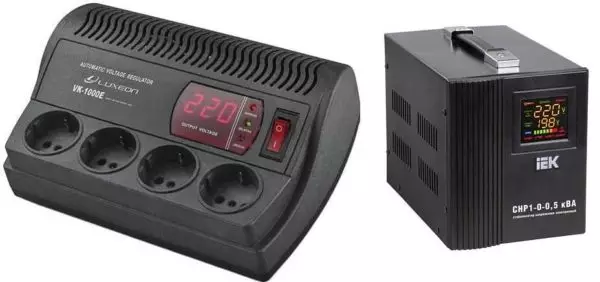
Local and general stabilizers - the first to decide
If the voltage "walks" in small limits and most of the equipment is working normally, and there are only problems with some kind of sensitive equipment, it makes sense to put local stabilizers - on specific lines or separate devices.
By the number of phases
The food in the house may be single-phase and three-phase. With single-phase (220 V) everything is clear: a single-phase stabilizer is needed. If there are three phases in the house / apartment, there are options:
- If there is an instrument that connects immediately to the three phases, then the voltage stabilizer is needed three-phase.
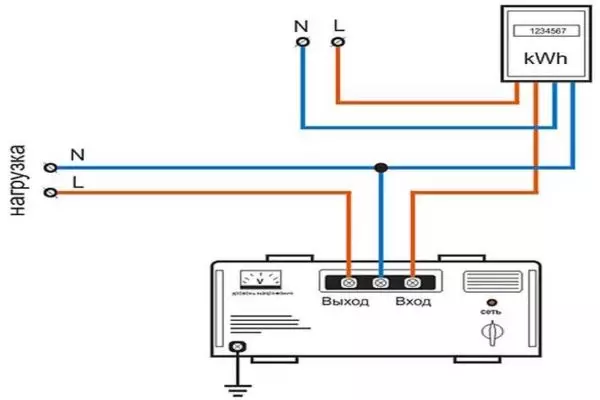
Connection diagram of stabilizer to single-phase chain
- If the equipment is connected only to one of the phases, one-phase stabilizers are needed to each of the phases. Moreover, their power does not have to be the same, since the load is usually distributed unevenly.
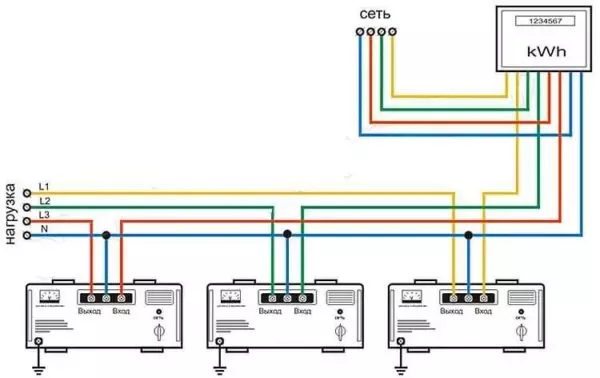
Three-phase chains can be put three single-phase
Select voltage stabilizer for home or cottage on this principle is easy. But it is necessary to determine.
Power selection
To select a voltage stabilizer for the house, first it is necessary to calculate its power. It is easiest to determine it on a machine that stands on the house or line. For example, the input automaton costs 40 A. Calculate power: 40 A * 220 V = 8.8 kVA. So that the unit does not work at the limit of opportunities, take the reserve for power 20-30%. For this case, it will be 10-11 kVA.
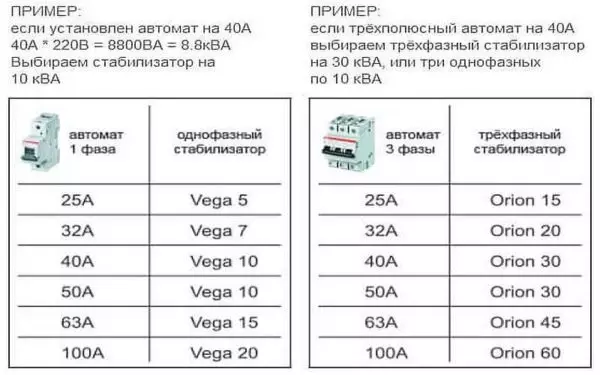
The choice of stabilizer power depends on the total power of the network or the instruments connected to it.
Also calculated the power of the local stabilizer, which put on a separate device. But here we take the maximum consumed current (there is in characteristics). For example, it is 2.5 A. Next, we consider the algorithm described above. But if there is a motor in the equipment (refrigerator, for example), then you need to consider starting currents that are at times exceeding the normative. In this case, the calculated parameters are multiplied by 2 or 3.
When selecting power, do not confuse kVA with kW. If short, then 10 kVA in the presence of tanks and inductances (that is, for real networks almost always) is not equal to 10 kW. The digit of the real load is smaller, and how less is depends on the inductance coefficient (may also be in characteristics). Under a specific device, it is easy to calculate everything - you need to multiply by the coefficient, but everything is more complicated for the network. Just if you see the number in KVA, take the order of about 15-20%. Approximately such a reactive component on average.
Accuracy stabilization
The accuracy of stabilization shows how smooth will be the outlet voltage. Acceptable is considered + -5%. With such a tolerance, domestic equipment works normally, but for imported it is necessary better stabilized stress. So, all stabilizers that have accuracy less + -5% are wonderful, everything worse is better not to buy.
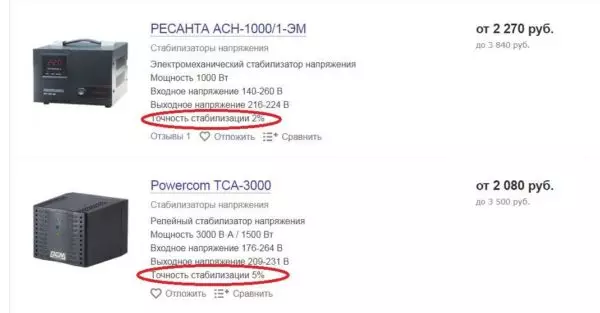
The accuracy of stabilization is one of the first parameters to pay attention to
Input voltage range: limit and worker
In the characteristics there are two lines: the limit range of the input voltage and the working. These are two different characteristics that displays different device parameters. The limit range is the one in which the device will at least somehow adjust the voltage. It will not always pull it up to the norm, but at least it would not turn off.
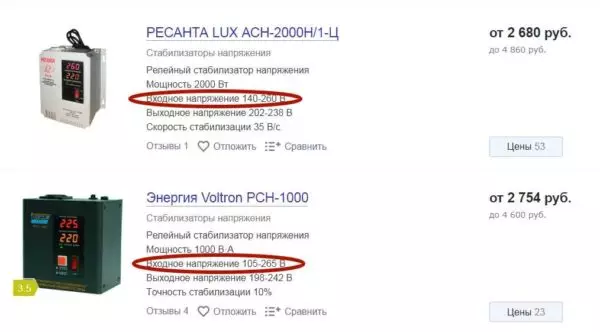
The limit range indicates not always, but there is a worker
The operating range of the input voltage is, just that running, in which the device must issue the claimed parameters (with the most accuracy of stabilization).
Load and overload
Very important characteristic for which you need to pay attention to. Load ability shows what load can "pull" the voltage stabilizer for the house when working at the lower boundary. There are such models that give the declared capacity by 220 V. That is, when it is not necessary at all. But at the lower limit of 160 V can only work with half load. The result - working under reduced voltage it can overcome. Even if you took it with a power reserve.

Load and transshipment should be requested additionally. Usually there is no technical characteristics.
Overloading capacity is no less important. It shows how long it can work with the excess of the load. The parameter is important even if the equipment you took with a good power in power. For this parameter, it is possible to indirectly determine the quality of the parts and the quality of the assembly. The higher the overload capacity, the more reliable equipment.
Species, pros, cons
Voltage stabilizers There are different types, make them components of different types - electromechanical, electronic. Some of them have electrical control, part-electronic. To properly pick up the equipment, you need to have an idea of the merits and disadvantages.
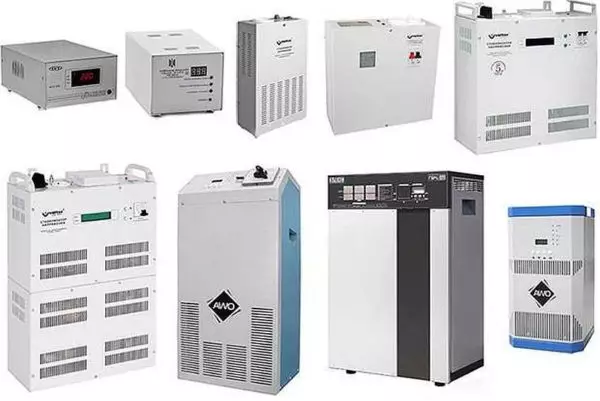
Species and types of voltage stabilizers for home many ....
Electronic (Symstorn)
Collected on simistors or thermistors. Have several adjustment steps that are connected / disconnected depending on the input voltage. Switching can occur using an electronic key (works silently, but it is a more expensive model) or an electronic relay (there is sound when there is sound).
The pluses of electronic stabilizers include a high reaction rate (the time of inclusion of one stage of about 20 ms). Electronic keys are triggered very quickly, connecting the desired number of correction steps or turning it off. The second positive moment is a quiet job. There is nothing to noise here - electronics operates.
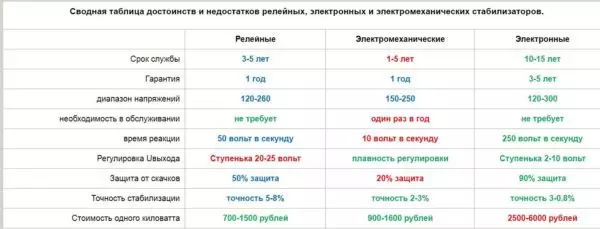
Comparison of the main types of stabilizers
Cons There are also. The first is the low accuracy of stabilization. In this category, you will not find models that give a stress with an error of less than 2-3%. It is simply impossible, since the adjustment of the step and the error is quite high. The second drawback is a high price. Simistors cost a lot, and there are as many as many steps. That is, the more steps and our adjustment accuracy, the more expensive equipment will be.
Electromechanical
Collected on the basis of an electromagnetic coil, which runs the slider. The position of the runner varies with a motor or relay. Plus electromechanical stabilizer - low price and high stabilization accuracy. Disadvantage - Low speed - parameters change slowly. The second minus is quite loud work.
Machines with a motor work quieter, but the adjustment occurs slowly. The average reaction time is 20 in 0.5 seconds. With sharp jumps, the device simply does not have time to change the voltage. There are one more trouble in stabilizers of this type - overvoltage. It occurs in that situation when the previously fallen voltage comes back to normal. The stabilizer does not have time to react, as a result, we have a jump, it happens to 260 V, and this is detrimental to the technique. In order to avoid a similar situation, the output is to protect the voltage (automatic voltage), which simply turns off the power.
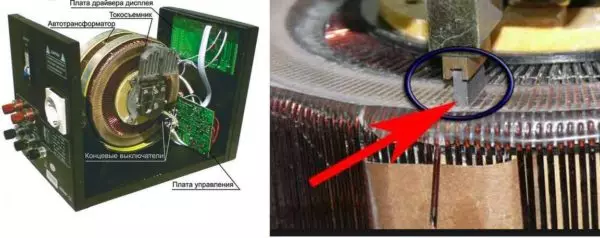
Electro-mechanical - inexpensive, reliable, but at low correction rate
If the electromechanical voltage stabilizer for the house is assembled based on the relay, the response time is less, but during operation they are noisy, and the adjustment is not smooth and stepped. This means that they have a lower stabilization accuracy. But there is no overvoltage and there is no need to think about additional protection. In order not to be confused, these devices call relay stabilizers that are as described in most cases.
There is another not the most pleasant moment in electromechanical stabilizers of stress for home or apartment: they are faster than wear, require regular prevention (once in half a year).
Ferroresonance
These are the most cumbersome of stabilizers. Have a small response time, high reliability and resistance to interference. The stabilization coefficient is medium (about 3-4%), which is not bad.
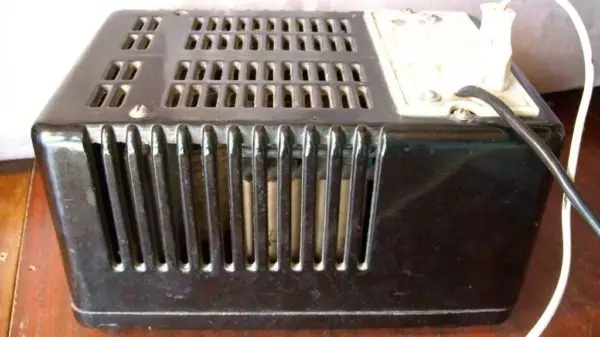
Ferro-resonance voltage stabilizers are not too popular due to large dimensions and mass
But at the output, the voltage has a distorted form (not sinusoid), work depends on changes in frequency in the network, is characterized by a large mass and dimensions. Usually used as the first stage of stabilization, if one device does not achieve normal voltage.
Inverter
This is one of the types of electronic devices, but its work and the inner structure are very different from those described above, because this group is considered separately.
In the inverter voltage stabilizers, a double conversion occurs first an alternating current turns into a constant one, then back to the variable, which is fed to the power factor corrector, where it is stabilization. As a result, we have an ideal sinusoid with stable parameters.
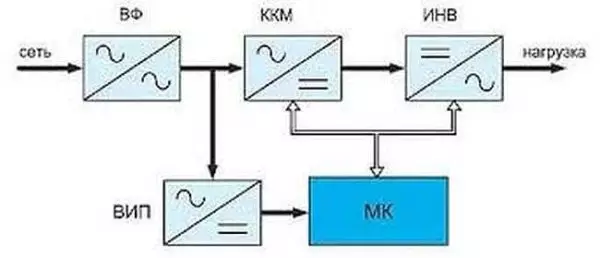
Block diagram of inverter voltage stabilizer
Inverter voltage stabilizer for home This is perhaps the best choice today. Here is his advantages:
- Wide working stabilization range. Normal indicator - from 115-290 V.
- Small response time - the delay is several milliseconds.
- High stabilization accuracy: averages in class 0.5-1%.
- At the exit, the perfect sinusoid, which is important for some types of equipment (gas boilers, such as the washing machines of the last generation).
- Suppression of any nature interference.
- Small sizes and weight.
At a price, this is not the most expensive equipment - they are about as much as relay and almost twice below electronic. At the same time, the quality of the transformation in inverter units is much higher.
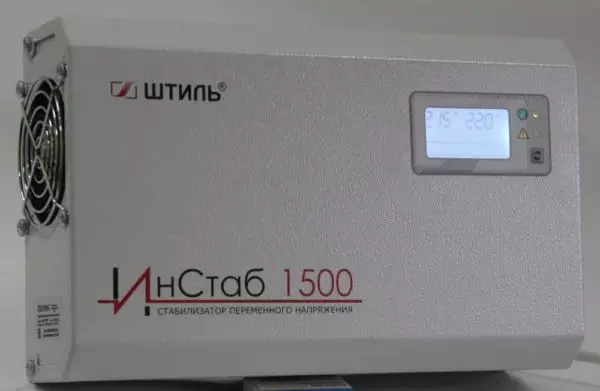
Russian manufacturer of Chang produces inverter voltage stabilizers for home and cottages
The disadvantage of this equipment is one: when working, the elements are very hot. For cooling in the case, fans are embedded, which publish a soft buzz. If the voltage stabilizer is chosen for the apartment, it is usually put it in the corridor, so noise can be heard. In private homes of opportunities for choosing the installation site more, so it is quite realistic to find such where noise will not interfere.
What stabilizer is better
To speak from the fact that some type of stabilizer is better, and some worse does not make sense. Everyone has their own advantages and disadvantages, each in some situation, under certain requirements - the best choice.
Let's look at the typical situations with which many are faced:
- Racing powered frequent, sharp. Voltage drops, it becomes higher than the desired one. For such a situation, high speed and absence of overvoltage is required. Electronic and inverter stabilizers possess such properties.
- The voltage in the network is often reduced, it almost does not reach the norm. There is a wide operating range here. From inexpensive models fit electromechanical and relay, from more expensive all the same inverter.

To make it easier to choose which voltage stabilizer is better
- Bought a new technique, and she does not want to work, gives a power error. The best option here is an inverter unit. He will not only reach the tension, but the sinusoid will give the perfect, and this is important for electronics.
There are really a lot of situations. But in any case, select the type of voltage stabilizer for the home, it is necessary to base their existing problem. Next, in the selected category, choose by parameters.
Choosing a manufacturer and prices
The most difficult thing is to choose the manufacturer. The ultrasound should be said that the Chinese units are better not to consider. Even with those that are Chinese only half (with the subsemore production and head office in another country), it is necessary to be very neat. Quality is not always stable.
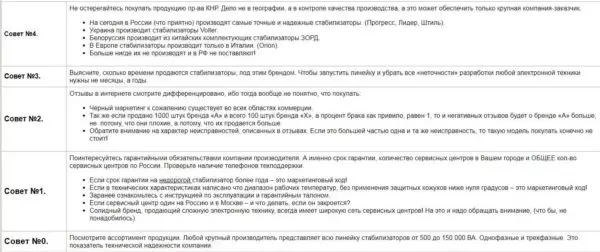
Tips for choosing a stabilizer
If you are not important an external component, pay attention to the stabilizers of Russian or Belarusian production. This is a calm and leader. Quite decent aggregates, with not very good design, but with stable quality.
If you need perfect equipment, look for Italian Ortea. They have both assembly quality, and appearance at height. Also good reviews from Reante. Their goods are estimated at 4-4.5 on a five-point scale.
Several examples of stabilizers of different types with a capacity of 10-10.5 kW with characteristics and prices are shown in the table. See yourself.
| Name | A type | Work input voltage | Accuracy stabilization | Type of allocation | Price | User rating on a 5-point scale | Notes |
|---|---|---|---|---|---|---|---|
| RUCELF SRWII-12000-L | relay | 140-260 B. | 3.5% | wall | 270 $ | 4.0 | |
| Rucelf SRFII-12000-L | relay | 140-260 B. | 3.5% | Outdoor | 270 $ | 5.0 | |
| Energy HYBRID START-10000/1 | hybrid | 144-256 B. | 3% | Outdoor | 300 $ | 4.0 | At the output, the perfect sinusoid, protection against short circuit, from overheating, from high voltage, from interference |
| Energy Voltron PCH-15000 | relay | 100-260 B. | 10% | Outdoor | 300 $ | 4.0 | |
| RUCELF SDWII-12000-L | electromechanical | 140-260 B. | 1.5% | Navy | 330 $ | 4.5 | |
| Resanta ACH-10000/1-EM | electromechanical | 140-260 B. | 2% | Outdoor | 220 $ | 5.0 | |
| Resanta LUX ASN-10000N / 1-C | relay | 140-260 B. | eight% | Navy | 150 $ | 4.5 | sinusoid without distortion Protection from short circuit, from overheating, from high voltage, from interference |
| Resanta ACH-10000/1-C | relay | 140-260 B. | eight% | Outdoor | 170 $ | 4.0 | sinusoid without distortion Protection from short circuit, from overheating, from high voltage, from interference |
| Otea vega 10-15 / 7-20 | electronic | 187-253 B. | 0.5% | Outdoor | 1550 $ | 5.0 | |
| Calm R 12000. | electronic | 155-255 B. | five% | Outdoor | 1030 $ | 4.5 | |
| Calm R 12000C. | electronic | 155-255 B. | five% | Outdoor | 1140 $ | 4.5. | |
| Energy Classic 15000. | electronic | 125-254 B. | five% | Navy | 830 $ | 4.5 | |
| Energy Ultra 15000. | electronic | 138-250 B. | 3% | Navy | 950 $ | 4.5 | |
| SDP-1 / 1-10-220-T | Electronic inverter | 176-276 B. | one% | Outdoor | 1040 $ | five | sinusoid without distortion |
Sparkling of prices is striking, but the types of equipment are collected here a variety of - from budget relay and electromechanical to super-reliable electronic.
Article on the topic: Construction of the pool in the country area with their own hands, photo
